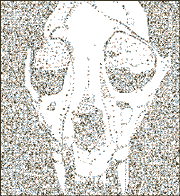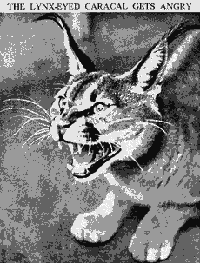 In the summer of 1995, the Ministry of Agriculture, Fisheries and Food produced a report which fuelled the media claim that the Bodmin Beast phenomenon was a hoax. Deterministic explanations were given such as mistaking a dog for a cat, size distortion, the wrong eyes, rural myth. In 1991, French sociologist Jean Baudrillard argued that the Gulf War was a hoax, that it was only a hyperreal representation over TV screens. Our own investigations have shown up strong evidence to suggest the Gulf War was a fake, storyboarded by top Hollywood film directors and executed by George Bush as a human sacrifice ritual to boost the flagging popularity of the multinational computer industry. This ruling class cultist sacrifice scenario has repercussions in the whole strange story of the Bodmin Beast phenomena, which we hope to illuminate in the following columns. On June 22nd 1995 we had our own close encounter in broad daylight with one of the Bodmin-area beasts, a lynx-like creature. I should mention that I worked for a while in London Zoo and have since had many dealings with both domestic and feral cats, so I am reasonably able to identify the various cat species. I recently came upon an illustration in the World of Wonder -10,000 Things Every Child Should Know, published by the Educational Book Co. Ltd. Of Whitefriars. This undated encyclopaedia was published around the time of the first Atomic power installation and edited by Charles Ray. The illustration,
 is captioned as follows: The caracal shown in this picture is an animal midway between the wild cats and the lynxes. It is larger than the wild cat but smaller than the true lynxes, and in colour is reddish-brown, the under parts being paler. Its most noticeable feature is the long ear, tufted with black hair. The eyes are very bright, and the common expression " lynx-eyed " is believed to owe its origin to this species and not to the true lynxes. The caracal is a rather rare animal, and is found in Asia and Africa. It is a creature of the grass and bushes rather than the forests, and its food consists of gazelles, small deer, hares and birds like the crane and pea-fowl. It is said to be able to spring up and capture a bird on the wing at a height of six feet. The caracal can be easily tamed and has often been made a pet. The animal we watched was indeed springing up and attempting to capture some small birds and made off into the bushes. It had a long tail with a black tip. From the many reports that have come in, it seems likely that there are at least three species of Big Cat living unofficially on the Moor, together with others that are beyond logic and beyond belief. The Bodmin Beast does not at present fit into the official 'tourist' outline of Cornwall, although we note that images of the lesser-known sea monster Moghar have crept into the tourist information offices. As far as we know, no-one has yet put in compensation claims connected with Moghar. We have also noticed overlapping patterns of Beastly sightings in Cornwall, with sites of Arthurian interest, ancient stone circles and sites used by local pagan groups. There is also evidence emerging that there are sinister implications involving animal sacrifice and sex magick in the psychic war within the Windsor family as to who is to wear the crown of the 'United Kingdom'. |